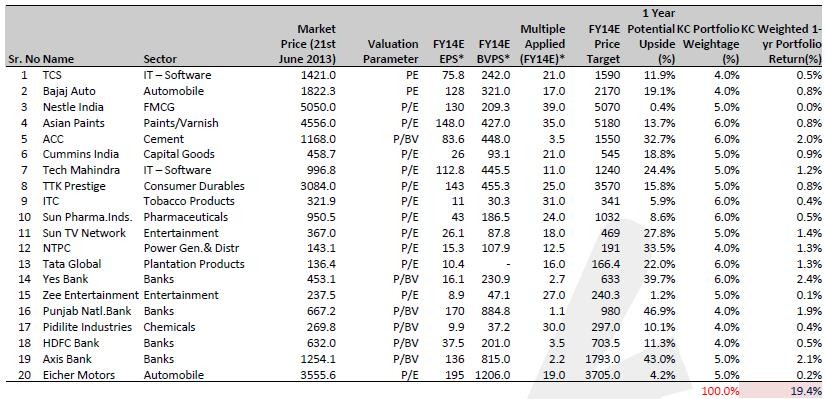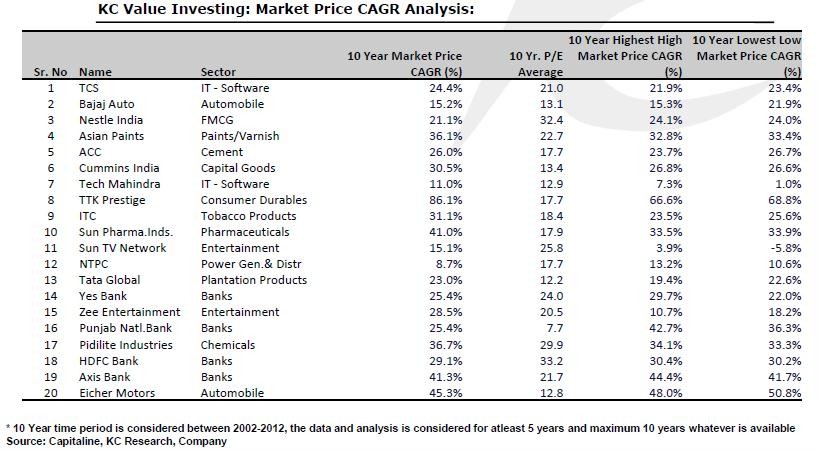Using Value Investing Criteria that Works Low Price to Free Cash Flow
Post on: 12 Апрель, 2015 No Comment

Using Value Investing Criteria that Works — Low Price to Free Cash Flow 2 comments
Aug 16, 2011 3:40 PM
In Value Investing we do not use only one set of criteria, clap our hands and say Eureka, I have it! We have several metrics that we can use in our Value Investing toolkit, sometimes in conjunction with each other to evaluate a company and discover if it is a bargain.
What is Low Price to FCF?
Two of the most important words in evaluating a company are Cash Flow. Old School Value Investing focused on Earnings. That is so 1950s. I am not going to go into the details of Free Cash Flow. Please see the Chroma Investing Value Investing Terms FCF for a fuller explanation than I give here. The short version is that Free Cash Flow is what a company really has left over at the end of the year. It is the amount that you can turnover to investors in dividends, buy back stock, pay down debt or just let sit on your balance sheet.
Low Price to Free Cash Flow (P/FCF) is a measure that value investors find useful to analyze companies finances in relation to its current stock price. It is a stricter measure than the price-to- operational cash flow ratio as it backs out capital expenditure. Here is the simple equation:
Price to FCF = Market Cap / Free Cash Flow
A high ratio indicates that a company is expensive relative to its Free Cash flow. A low ratio shows that it is cheap in relationship to FCF. Like most of these value investing metrics you can reverse these and you will get the Free Cash Flow yield which is expressed as a percentage. With a Free Cash Flow yield, higher is better.
Simply put, Free cash flow is a measure of a companys ability to generate cash, which is a starting point for stock pricing. Or, as Warren Buffett said, Intrinsic value can be defined simply: It is the discounted value of the cash that can be taken out of a business during its remaining life.
An easy formula for free cash flow is, FCF = Operating Cash Flow Capital Expenditures. The numbers needed for the calculation are found on the Cash Flow Statement of the Financial Reports that a company issues in its 10K or 10Q.
How to use P/FCF in an Investment
Lets say you agree that using FCF can help you make your value investing decisions, how might you go about it? Here are a few suggestions.
1. You can buy stocks in companies that are low in Price to FCF as compared to the market as a whole. That is you can compare the P/FCF of a company to that of the overall market. For example you could compare the FCF ratio of General Electric to the S & P 500. Although, I could not find this information on Standard and Poors own website.
2. You can compare Free Cash Flows to some arbitrary number, say 10 or 15. You may want to do this if you can come up with some historic norm for Free Cash Flow. If you can review historical data of FCF over a long period of time, it is possible to come up with a normalized ratio. You could use that number as your comparison. Again, this will be difficult since historic data for Free Cash Flow is difficult to obtain very far back.
3. You can buy a stock using P/FCF either as a solo investing criteria(not recommended) or in combinations with other factors. For example you might use FCF ratio with such metrics as low price to book, a high acid test ratio, high ROIC, etc.
4. You can buy a stock when a company has a Low P/FCF in relationship to its own 5, 7 or 10 year financial history. I always like to compare current ratios to historic ones to get a relative idea if this metric is cheap for this particular company.
5. You can buy the stock of a company who Price to Free Cash flow is low relative to its industry. In other words you take a look at Exxons FCF ratio and compare it to the oil industry as a whole to get a relative industry ratio.
6. You can buy a fund that specializes in Low Price to FCF. This may be an index mutual fund or an ETF. I dont know of any pure play funds on Low P/FCF, since most value funds use a combination of factors, but perhaps there is one that has escaped my notice.
So, why is low price to free cash flow so important, that it is worth investing?
Importance of Low Price to FCF
Low P/FCF has been a good indicator in the past of what makes a successful investment moving forward. Let me give a few examples.
Peter George Psaras wrote a study called Back-test showing the power of Price to Free Cash Flow in the Investment Process where he back tested buying Low Price to Free Cash Flow stocks from the Dow Jones Industrial Average for 1950 to 2007. His criteria was simple: buy every stock that had a Price to FCF ratio less than 15 and sell it after a year. The results were remarkable. The performance was 22.77% on average over the 58 years. The average gain for the DJIA was only 7.82% for the same period. Quite an outperformance
I asked myself the question, what does this mean right now. So I created a stock screen with Stock Investor Pro using data from last Friday August 5 th. Here are the companies passing the screen:
I am not recommending any of these companies, but it does give you some idea why some high profile value investors are interested in Microsoft, Pfizer and Cisco to name a few. Perhaps a few of these companies are worth some further research.
Other investing studies have used the less stringent Low Price to Cash Flow ratio (P/CF). Lets see if there was a similar outperformance.
Does Low Price to Cash Flow work in shorter time Frames.
In their study, Contrarian Investment, Extrapolation and Risk, Josef Lakonishok, Robert W. Vishny and Andrei Shleifer reviewed all the companies on the AMEX and NYSE from 1968 to 1990. They divided up the companies in to ten selections called deciles by Price to Cash Flow. They formed portfolios that they kept for five years. What they discovered is that the lowest Price to Cash Flow stocks outperformed the highest Price to cash flow stocks on average during a holding period of 5 years. The average return for the low P/CF stocks was 20.1% per year and amongst the high P/CF stocks it was only 9.1% with cumulative 5 year return of 149.4% to 54.3%. Perhaps not as exceptional as the Psaras study, but significant none the less.

This is one of those studies that is useful only in the abstract. Realistically an investor is not going buy the lowest 10% of p/cf companies on any exchange. But it does continue to show that when you are considering value investing metrics that P/FCF should remain in the toolkit.
Low Price to Cash Flow Internationally
All this may be well and good in the United States, but do these kind of value investing metrics work abroad? A. Michael Keppler looked at this in his study Further Evidence on the Predictability of International Equity Returns: The Importance of Cash Flow in Country Selection. While he did not use FCF specifically, it is instructive. He found that from 1970 to 1989 in the eighteen countries studied that the lowest price to cash flow country indexes produced a result of 19.2% on average in local currencies compared to the highest Price to cash flow country indexes with a return of only 4.7 % in local currencies.
Since this was based on buying index funds this study has an actionable element. But it would require a little research. You dont think I am spoon feeding you everything, do you? An investor could research index funds based on different countries stock markets. They would need to have P/CF information on each index (preferably FCF). Compare the indexes and pick a small basked of low cost to cash flow indexes.
If anyone does this research please report back.
Why does Price to FCF work as a Value Investing Metric?
No one knows for sure but here are a couple of my guesses.
1. Companies with low prices related to any value metric, Earnings, Book Value, Sales etc. are unpopular. Otherwise their price wouldnt be low. Something is bothering the market, bothering it so much that it MAY be undervalued. Low Price to FCF investments are a contrarian investment by definition, and mostly people want to say they own Apple or Netflix, not Aeropostal or Microsoft.
2. Cash Flow may be more honest than earnings, a commonly used measure of a companies performance. As Damodaran said in his book Investment Fables, Accountants measure earnings by subtracting accounting expenses from revenues. To the extent that some of these expenses are non-cash expenses and because accrual accounting does not always yield the same results as cash accounting, accounting earnings can be very different from cash flows. (Italics are mine)
Having a healthy Free Cash Flow gives a company options. It is a sign of a financially sound company thriving in its industry. Free cash flow is often used for stock buy backs, dividend payments and in reducing debt.
Finding such companies is usually easier in a bear market or when a company misses earnings, makes a mistake which leads to bad press, all of which can temporarily depresses its stock price. Investors finding such opportunities should, as they say, strike while the iron is hot.
Please come to ChromaInvesting.com each week as we write about various Value Investing Criteria to help you build your Value Investing arsenal. Add your comments if you have any thoughts about using Low Price to FCF in investing. Finally, if you havent already done so, please sign up for our email list (I promise I wont spam you.) or like ChromaInvesting on Facebook.
Disclosures: I do not have any financial interest with aaii.com or Stock Investor Pro, but I am a paid member of the first and I have purchased the second for the past two years. I am making no recommendations on stock purchases or sales, just expressing my opinion on what I am exploring right now. I am not a professional investment advisor but a Film and television producer, thus everything here is for entertainment purposes only.
Instablogs are blogs which are instantly set up and networked within the Seeking Alpha community. Instablog posts are not selected, edited or screened by Seeking Alpha editors, in contrast to contributors’ articles.














